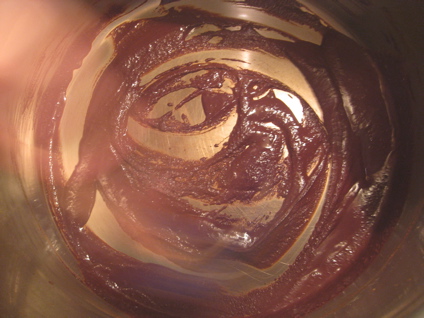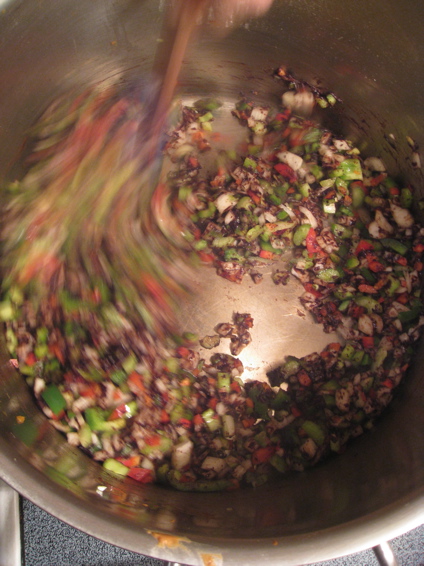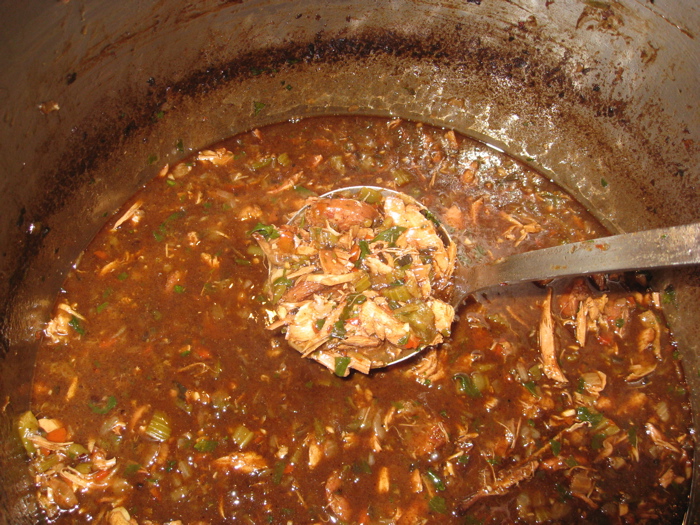 Turkey gumbo: the Thanksgiving centerpiece finds its true calling. All photos by April McGreger
Turkey gumbo: the Thanksgiving centerpiece finds its true calling. All photos by April McGreger
Before accepting a Thanksgiving dinner invitation, I ask my host two questions: Will you be roasting a turkey and may I have the leftover carcass? The best part of the Thanksgiving turkey has long been about leftovers for me, but a few years ago I upgraded from mundane turkey sandwiches to the exceptional turkey bone gumbo.
I have long been a fan of wild-duck gumbo, but the first that I heard of turkey bone gumbo was from my friend Sara Roahen, who devotes a whole chapter to it in her charming book about living and eating in New Orleans, Gumbo Tales. The idea appealed to both my thriftiness and to my holiday homesickness. The first year that I made the gumbo was the first year that I bought a heritage-breed turkey. Whereas the carcasses of previous Thanksgiving birds at my parents’ house had ended up in the trash, I had paid a small fortune for this bird and was determined to get every bit of use from it that I could. Making a gumbo from the leftover bird seemed a lot more exciting than just a simple turkey stock. Heritage breed birds have a richer, fuller flavor and make wonderful soups, so making gumbo turned out to be a perfect use for the leftovers.
Making gumbo is also huge part of who I am. I grew up at the northern end of the gumbo belt, and I got my first lesson in making a roux in college from my friend’s mother in her Baton Rouge home. I also got copies of both Marcelle Bienvenu’s charming Who’s Your Mama? Are you Catholic? And Can You Make a Roux? and Paul Prodhomme’s resourceful Louisiana Kitchen during those years and began my own gumbo making efforts in earnest. Gumbo eating was a year round affair, but the holidays were a particularly fruitful time. After our college holiday breaks, students from the Gulf South would show up with a gallon or two of their mama’s gumbo and invite everyone they knew over for a feast. There is nothing quite like a bowl of steaming gumbo and good friends on a cold winter night.
I now live far outside of gumbo territory, but I still like to make it every chance I get. There is nothing inherently difficult about making gumbo, but for some reason, it is extremely difficult to find a good bowl of it outside of the Gulf South. For that reason, I see myself as a gumbo ambassador to the Up South and beyond. I am looking forward to making a delicious turkey bone gumbo for friends who are gathering in D.C. this weekend to celebrate Thanksgiving together.
 You won’t roux the day. Before you make your gumbo, I feel it’s important to tell you a bit about this epic dish. It is a stew popular in Louisiana and the Gulf South whose name most likely comes from the Central African Bantu word for okra, gombo. There are as many different gumbos as there are cooks. Most start with a roux but there are exceptions. Some contain okra, particularly seafood gumbo. Some contain the Choctaw Indian file powder, or ground sassafras, particularly wild game gumbos. It is usually served with rice and sometimes, peculiarly over potato salad.
You won’t roux the day. Before you make your gumbo, I feel it’s important to tell you a bit about this epic dish. It is a stew popular in Louisiana and the Gulf South whose name most likely comes from the Central African Bantu word for okra, gombo. There are as many different gumbos as there are cooks. Most start with a roux but there are exceptions. Some contain okra, particularly seafood gumbo. Some contain the Choctaw Indian file powder, or ground sassafras, particularly wild game gumbos. It is usually served with rice and sometimes, peculiarly over potato salad.
If you’ve never made gumbo, it’s actually very simple. You should allow a relaxing 4 hours to make your first gumbo and enlist your friends or family to help with the chopping. I like to break this prep time up by getting my chopping and turkey stock making done early in the day, then allowing just a couple of hours in the evening to make them gumbo. A nice bottle of wine helps, too. Gumbo can be thought of in three parts: the roux, the seasonings, and the stock.
 Stir the pot: gumbo’s holy trinity of aromatic seasonings. The roux is usually what intimidates people from trying to make gumbo, but it is actually quite simple. It is just a paste of flour and fat that is stirred constantly over heat until it browns. There are just two secrets to browning your roux without burning it: use a heavy-bottomed pot, and don’t stop stirring. There is a range of acceptable levels of of roux “brownness.” Some recipes tell you to make a “red” roux, others say cook your roux until it’s the color of peanut butter, dark brown sugar, or as dark as coffee. Coffee-colored rouxs are intensely flavored and overpower subtle flavors like those of seafood, but go lovely with wild game or a richly flavored heritage turkey.
Stir the pot: gumbo’s holy trinity of aromatic seasonings. The roux is usually what intimidates people from trying to make gumbo, but it is actually quite simple. It is just a paste of flour and fat that is stirred constantly over heat until it browns. There are just two secrets to browning your roux without burning it: use a heavy-bottomed pot, and don’t stop stirring. There is a range of acceptable levels of of roux “brownness.” Some recipes tell you to make a “red” roux, others say cook your roux until it’s the color of peanut butter, dark brown sugar, or as dark as coffee. Coffee-colored rouxs are intensely flavored and overpower subtle flavors like those of seafood, but go lovely with wild game or a richly flavored heritage turkey.
In gumbo-speak, seasonings include the holy trinity of vegetables: onion, green peppers, and celery. Sausage is also common–preferably a smoked andouille, but a good smoked country or garlic sausage makes a fine substitute. You should have all of your seasonings chopped and ready to go before you begin making your roux.
Your third component is the stock. Before making your stock, first pick off all of the bits of meat that you can from the carcass, and reserve for adding to the gumbo just before serving. You will be pleasantly surprised by how much meat falls off the well-carved turkey while it is simmering. The bones and cartilage will make a very flavorful stock when slowly simmered.
So what are you waiting for? Get out your pots, gather your friends and family and start cooking!
Turkey Bone Gumbo
Roux:
1 cup fat — I used a combination of sunflower oil and lard from pasture-raised hogs
1 heaping cup all purpose flour
Seasoning vegetables & sausage:
1 1/2; cups chopped celery
1 1/2; cups chopped green pepper
3 cups chopped yellow or white onion
Salt
Black pepper
1 pound Andouille or country sausage, preferably smoked, cut into bite size pieces
Turkey & turkey stock:
Turkey carcass, picked of at much meat as possible and reserved
1 gallon water
3 Bay leaves
A pinch of cayenne
A handful of fresh thyme sprigs or a teaspoon of dried thyme
A handful of Parsley stems
1 onion, quartered, plus the skins from your chopped onion seasonings
1 carrot, cut into 1-inch chunks
2 stalks of celery, plus ends and pieces from your chopped celery seasonings
Ends and pieces from your chopped green pepper seasonings
A couple of smashed garlic gloves
1 tablespoon whole peppercorns
2 whole allspice berries, optional
A few drops of hot sauce
Several pinches of salt
To Finish:
1 cup chopped scallions, thinly sliced
1 cup chopped parsley
Buttered white rice
File powder, delicious, but optional
Hot sauce
1. First assemble all of your seasonings and have them at the ready and your stock well under way before you begin making your roux.
2. In a large stock pot, start your turkey stock. Your carcass needs to be fully submerged under water. It will likely be necessary to cut your carcass down the breast bone or into several pieces to make this happen. Bring the stock to a gentle boil, then turn down to a steady slow simmer and cook for about 2 hours. Taste stock for seasoning and add more salt if necessary. Remove the carcass from the stock and set aside to let cool. When cool enough to handle, meticulously pick the meat from it and set aside. Strain the stock and reserve.
3. Make your roux: In a large, heavy bottomed pot, heat your oil over medium to medium high heat. Whisk in your flour. Stir continuously (I really like my square-edged wooden spoon for this task) until your roux is the color of dark brown sugar or chocolate. This may take 45 minutes or more. Take turns stirring with your friends or family, but keep stirring. A burned roux is a sad, sad thing. If you are afraid that your roux is burning, turn down your heat.
4. Dump your vegetable seasonings – onion, celery, and green pepper- into your roux and stir. Add a good pinch of salt and pepper and cook until wilted, about 5 minutes. Add your sausage and cook 5 minutes more.
5. Next whisk in gradually about 8 cups of stock. Bring to a simmer and cook uncovered for 1 1/2; hours. Add your reserved turkey meat and simmer another 10 minutes then stir in your parsley and scallions. Taste for seasoning and add more salt and pepper as desired. Serve over hot, buttered rice and pass the hot sauce and file powder at the table.


